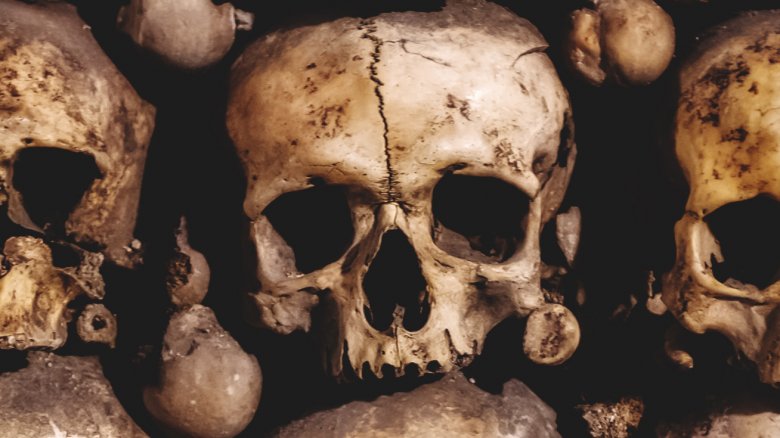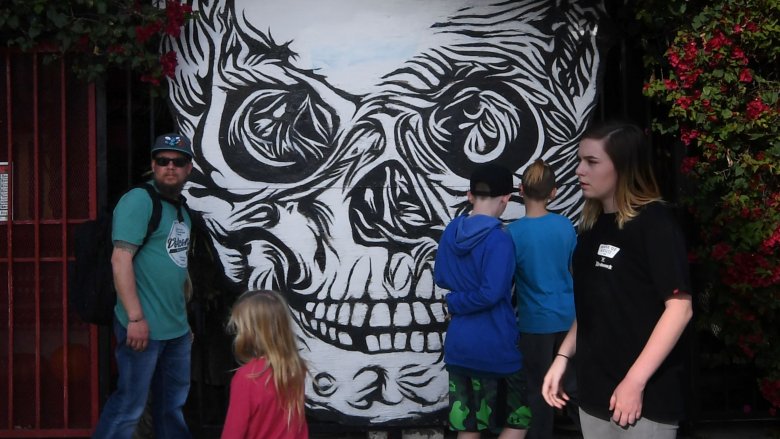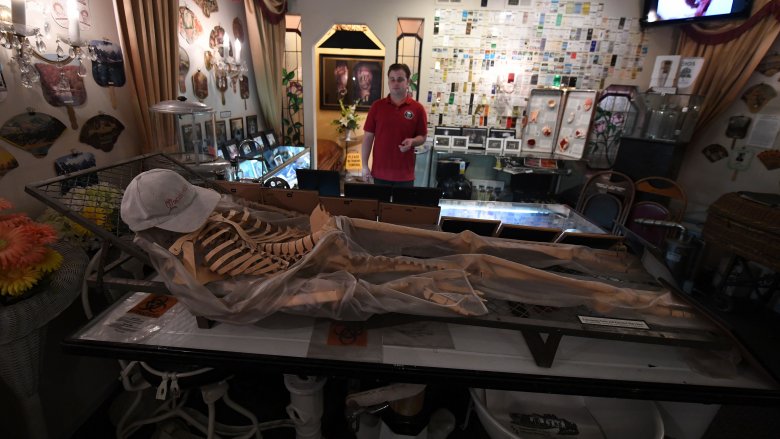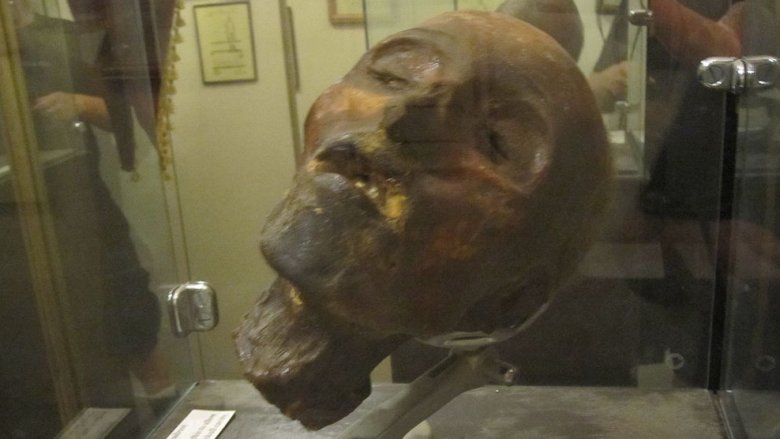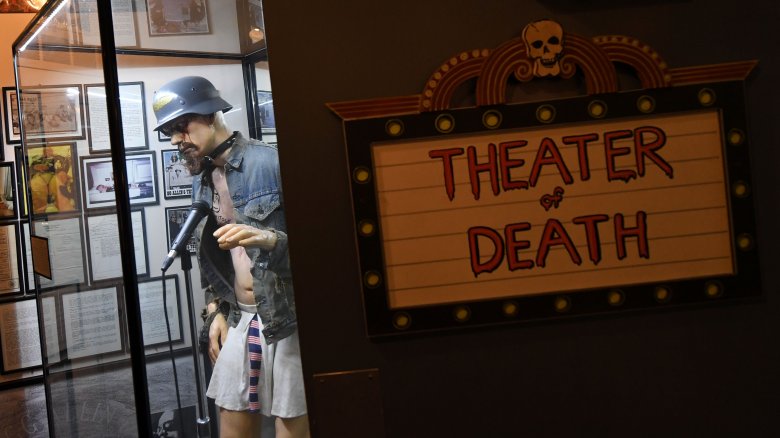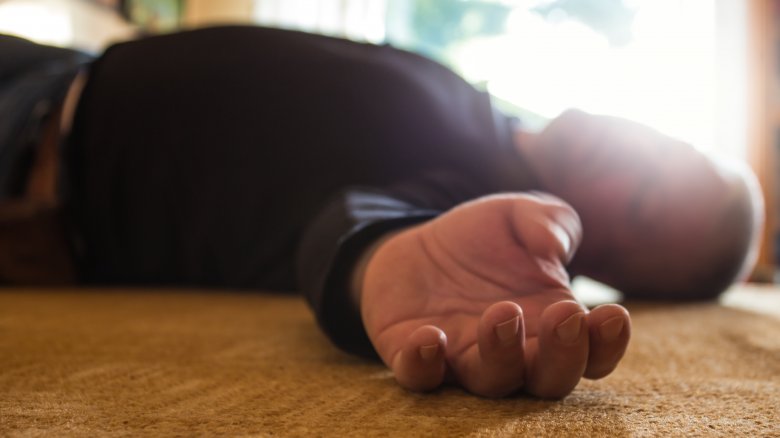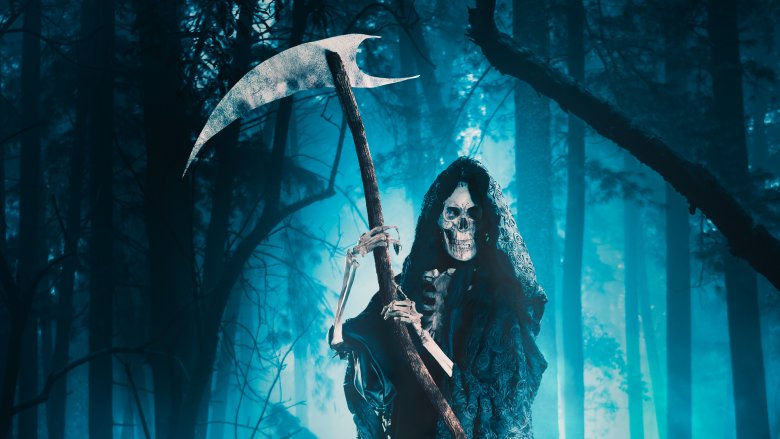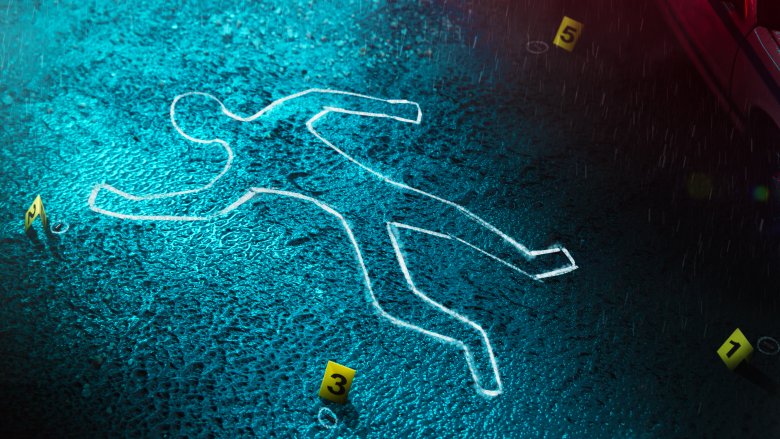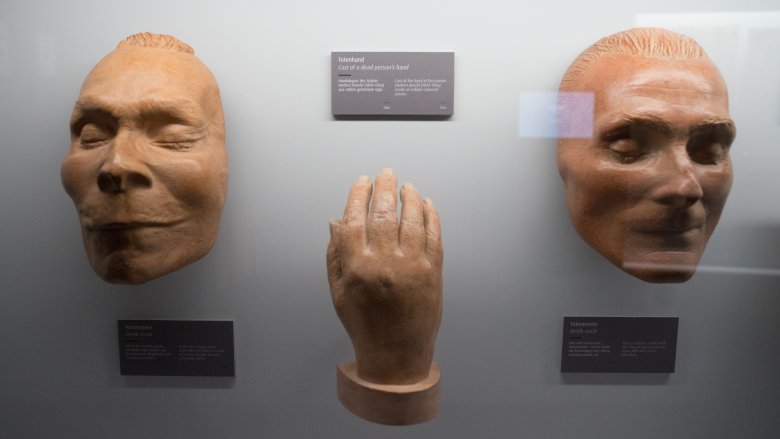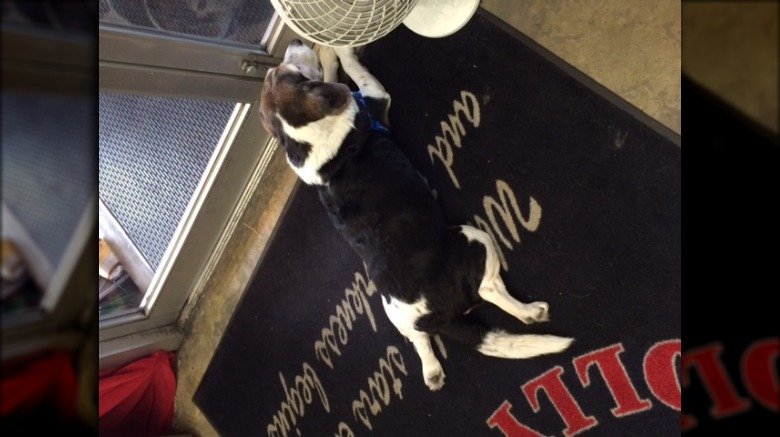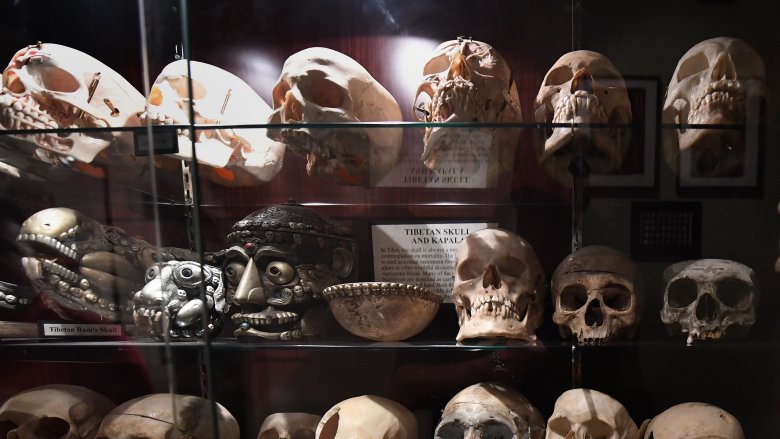The Untold Truth Of The Museum Of Death
There are a whole bunch of horrendous circumstances that you can avoid, but death isn't one of them. No matter what, your sheer existence on Earth is bound up with the fact that at some point, sooner or later, you're going to go kaput. Sorry.
Despite this unarguable fact, U.S. culture often tiptoes around death. It is avoided in polite conversation, discussed in euphemisms — I.E., "passing away" or "dearly departed" or "go kaput" — and most people go about their daily lives acting as if the Grim Reaper will never come. That's decidedly not the case at the Museum of Death, an intentionally grim and morbid fixture in both Hollywood and New Orleans that aims to shine a bright, glaring spotlight at all things dead and/or dying. Not surprisingly, the Museum of Death has become a rather controversial attraction. Certain aspects of the enterprise are questionable, but is there perhaps more depth to the proceedings than critics often admit?
What is the Museum of Death?
First things first. If you have never heard of the Museum of Death, and you're wondering if this place is really what it sounds like ... yes, it's pretty much exactly what you're picturing. No, really.
Founded in 1995 to "fill the void in death education in the USA," the Museum of Death has become a Hollywood fixture, which some tourists see as the perfectly dark counterbalance to the glittery Walk of Fame, TCL (formerly Grauman's) Chinese Theatre, and so on. To be clear, the Museum of Death is no cheerful or meditative place which celebrates death as a part of life, examines beliefs about the afterlife in various world cultures, or anything like that: rather, it's a no-frills menagerie of disturbing photographs, exhibits, gruesome imagery, videos, torture devices, body bags, mortuary equipment and so on, guaranteed to turn your stomach. If you're wondering who could be behind this whole thing, well, the founders are a married couple named Cathee Shultz and J.D. Healy, and the purpose of their enterprise is, according to The Independent, "To make people happy to be alive."
Death, death, and more death, everywhere at the Museum of Death
Now, don't get too paranoid. When you first pull up to the Museum of Death, you shouldn't expect to be shot with a poison arrow, dropped in a coffin, fed to zombies, or anything so hostile. All visitors, who can take an approximately 45-minute self-guided tour through the museum, should expect to come and go with a live, beating heart ... in their chest, of course. The exhibits, though, are a different story, according to Roadside America.
There is a seemingly endless assortment of disturbing stuff to peruse, starting with real severed body parts, and leading to an alleyway featuring a series of equally real photographs taken by a woman and her new boyfriend, posing naked with pieces of her dismembered ex. And you thought your last Tinder date was bad. In other rooms, an infant's casket is on display, as is artwork created by serial killers like John Wayne Gacy, and taxidermy animals such as Chihuahuas and a two-headed chicken. On the more famous side, there are exhibits specifically devoted to the JFK assassination, the Charles Manson murders, the Black Dahlia killing, and an exhibit that recreates the 1997 Heaven's Gate Cult Suicide, featuring an actual bunk bed from the house where it happened. These are, for the record, just a few examples of what the Museum of Death features.
The Museum of Death has the mounted head of a serial killer
Henri-Désiré Landru, a man sometimes known as the "Bluebeard of France," was a rather unsavory character. According to Bonjour Paris, Landru started by swindling elderly widows out of their money, which was bad enough, and then progressed into committing vicious murders. His method was to place lonely advertisements in Paris newspapers, describing himself as a wealthy widower who wanted to find a widow to marry: he would spend months romancing each woman he met, then murder them, dismember their bodies, and burn the remains. Awful stuff. In 1921, finally, he was arrested, stood trial, and convicted. As punishment for his crimes, he was placed under the guillotine in Versailles ...
... and somehow, his decapitated head ended up in the Los Angeles branch of the Museum of Death, where it continues to be mounted to this day. It's no surprise that the museum would be interested in this artifact, considering its grim subject matter, but it is rather odd that the disembodied head of a serial killer, almost exactly a century old, would have been preserved for this long.
The Museum of Death's creators
J.D. Healy and Cathee Shultz are the married duo who masterminded the Museum of Death. They look conventional enough, at first glance, but as you'd probably assume, their preoccupation with morbid stuff isn't a new hobby. According to Vice, their collection began in the nineties as a simple art show. As they toured around, one piece that particularly drew the attention of audiences was noted for featuring the names of every person currently on death row in the United States: In response to this interest, the couple wrote to these same prisoners, and asked them to submit art and diary submissions.
From there, as reported by The Independent, the art show grew, eventually becoming a full museum's worth of macabre materials. Ready to take things to the next level, Shultz and Healy initially rooted down in a former mortuary in San Diego's Gaslamp Quarter. This mortuary, as it happens, had its own eerie history, including a former brothel upstairs and a grim suicide by a former employee. But the owners of the building weren't so eager to share these anecdotes, nor were they happy with all the press that the Museum of Death accumulated over time.
The Museum of Death: from eviction to expansion
The original San Diego location of the Museum of Death was perfect for the museum itself, being a former mortuary and all ... but not so great for the proprietors of the building, according to The Independent, particularly when they wanted to take advantage of rising real estate prices by selling the location off. To them, housing such a morbid museum didn't feel like the best advertisement in the world, and evidently, it was believed that skeletal exhibits and torture devices lowered the property value.
So, Healy and Shultz got kicked out. Oops.
Not deterred, the couple simply packed their boxes, hit the highway, and shipped off to a new location in Hollywood, California, where they have been happily stationed ever since. A few decades later, according to Atlas Obscura, the brand had become successful enough that they were able to set up a second location in New Orleans, where all this grimagery fits right in with the cemetery tours and Marie Laveau's house.
The Museum of Death's strange and remarkable location
Even though the new Hollywood location doesn't have the same creepy backstory as the San Diego spot, it has proved to be a prime spot for the Museum of Death. Part of this is because the museum simply fits more cleanly into Hollywood's general sense of excess and exaggeration. Another part, most likely, is its close proximity to both the Walk of Fame and the Hollywood/Vine metro station, both of which bring in tons of visitors. Still another factor, to top it all off, is the uniqueness of one-story building itself.
As the Culture Trip points out, the location was formerly the home of Producers Studio, and later, Westbeach Recorders, meaning that famous bands such as Pink Floyd recorded albums within the same rooms that now house caskets and murder instruments. The building itself was constructed with deadening agents inside the walls — including, according to Roadside America, literal sand — which creates deep, unsettling acoustic effects as you move from room to room, looking at violent clips or photos, hearing some of the graphic noises being emitted. It creates an unsettling effect, to say the least.
Fainting is rewarded at the Museum of Death
The graphic material exhibited in the Museum of Death is the sort of thing most people avoid. Every once in a while, though, a morbid visitor drags their not-so-morbid friend or family member through the doors, and the results are about what you'd expect. According to National Geographic, co-owner J.D. Healy humorously keeps a whiteboard tally of every guest who has ever vomited or fainted due to the museum's content. Surprisingly enough, he claims that the number is much lower than you'd expect.
However, those who do pass out at the Museum of Death aren't mocked or derided. Far from it, they are actually rewarded for their efforts. According to Atlas Obscura, fainting incidents are deemed "falling down ovations" by the powers-that-be, and these individuals are even gifted with free t-shirts that say "I passed out at the Museum of Death ... and lived to talk about it." If nothing else, that's a great promotional tactic.
Is the Museum of Death ... um, healthy?
Well, you wouldn't be the first person to ask.
The stated goal of the museum is to spur more conversation around death, and thus foster a more open culture which, ideally, would examine harsh and/or unpleasant realities instead of shying away from them. This is, on the surface, an important goal, particularly in the United States. Examining death upfront, instead of glossing over it with metaphors and euphemisms, is definitely a healthier approach to the great unknown, as exhibited by Mexico's celebration of Día de Muertos, AKA the Day of the Dead. Known for its colorful skeletons and joyous parades, this ancient holiday celebration also makes a point to honor the deceased, as described by Medical Daily: Many families set up altars in remembrance of their lost loved ones, as well as cleaning their grave sites, and sharing drinks with fellow mourners in the cemetery. It's a highly positive, healthy, and honorable way to approach death, grief, and loss.
The Museum of Death is ... not that. While it allegedly comes from similar motivations, there's a big difference between honoring the deceased with smiling skeletons, or having passers-by pay money to look at gruesome murder photographs. That said, as National Geographic suggests, the Museum of Death is a direct response to the fact that U.S. culture considers death such a taboo subject, and the exhibits do depict tragically real events. So, judge for yourself, but it's definitely a complex topic.
The cultural obsession with "true crime" is another topic entirely
Now, "death" is one thing. It's a ubiquitous aspect of human existence. However, the common media sensationalism of "true crime" that the Museum of Death also represents — real serial killers being treated like celebrities — has far more disturbing implications, which haven't yet been thoroughly examined.
As Vice points out, the public fascination with true crime goes back over a century, if not longer. It is believed that such widespread interest arises from a human desire to steady oneself, in a world that often feels out of control, by "solving" crimes, murders, and so on, via reading about them or watching them on TV. That's understandable enough. The unhealthy part, though, is the glamorization of serial killers as being "anti-heroes" or celebrities, whether in big budget films like Natural Born Killers or the fact that some people write love letters to real murderers in prison. The BBC argues that part of the issue arises from a common focus on examining the killers themselves, instead of recognizing the real pain, hardship, and suffering of the victims — both alive and dead — who bear the brunt of these crimes.
So, is this a societal issue? Furthermore, does the Museum of Death help to unwind this problem, or just further propagate it? These are big questions, and the answers aren't so easy to address.
Similar, but different
Though the Museum of Death is quite controversial, and there's nothing else that quite mirrors its general gruesomeness, the world is full of intriguing and/or bizarre museums ... some of which, yes, tackle the subject of death quite openly. For example, the National Museum of Funeral History in Houston, Texas, provides a fascinating look at the history of funerals, memorials, cremation, and so on. It gives visitors opportunities to learn about caskets, to demystify the process of how funerals are put together, and to learn about the services that have been offered for famous deceased individuals like popes and presidents. Interesting, no? Meanwhile, over in Amsterdam, you can find the Dutch Funeral Museum, established in 2007 at the De Nieuwe Ooster cemetery. Once you grab a coffee at the entrance's Roosenburgh cafe, you can peruse through four exhibition rooms examining the funeral traditions of different cultures and religions. Over in Austria, there is also the Funeral Museum at Vienna's Central Cemetery, which displays hundreds of deathly items that stretch back for centuries.
So yes, these things are out there, and probably becoming more popular with every passing year. These days, it seems that death is a hot topic ... but really, hasn't it always been?
And now, his watch has ended
In the past, one not-so-grim thing that visitors to the Hollywood Museum of Death could always look forward to seeing was the wagging tail and loving eyes of Buddy, the exhibit's very alive "watchdog" beagle. Buddy was known for laying down on his stomach in the threshold of the front door, often requiring visitors to step over him, and he was said to be a source of comfort to any tourists who got freaked out about the museum's less-friendly subject matter. Hey, when in doubt, snuggle with the dog, right?
Sadly, the museum's website recently reported that Buddy had died of natural causes. They said that his death was peaceful, and he was surrounded by family. Lest you believe all this dog love is too soft and cuddly for the Museum of Death, though, think again: In addition to all the kind words, it was also announced that, in order to preserve Buddy's legacy in the museum, his remains would be stuffed by a taxidermist, mounted, and eventually returned to the museum as a permanent fixture, alongside the various other stuffed animals that are exhibited there.
Things to know before you visit the Museum of Death
If all these eerie descriptions have not deterred you from your decision to visit the Museum of Death, make sure you know exactly what you're getting into, because this kind of thing had different rules than your average museum.
For one, don't bring kids. Seriously. As LoveToKnow says, the exhibits in the museum are exceedingly graphic, if you haven't already gathered, so you'd also do well to avoid bringing any family members or friends who have weak stomachs, or are prone to fainting ... well, you know, unless they want the free t-shirt. Also, do note that cameras and photographs (yes, including your cell phone) are strictly prohibited from the building, so don't try to sneak something through. Honestly, though, would you really want to bring photos of these exhibits home, much less post them on Instagram? Didn't think so.
